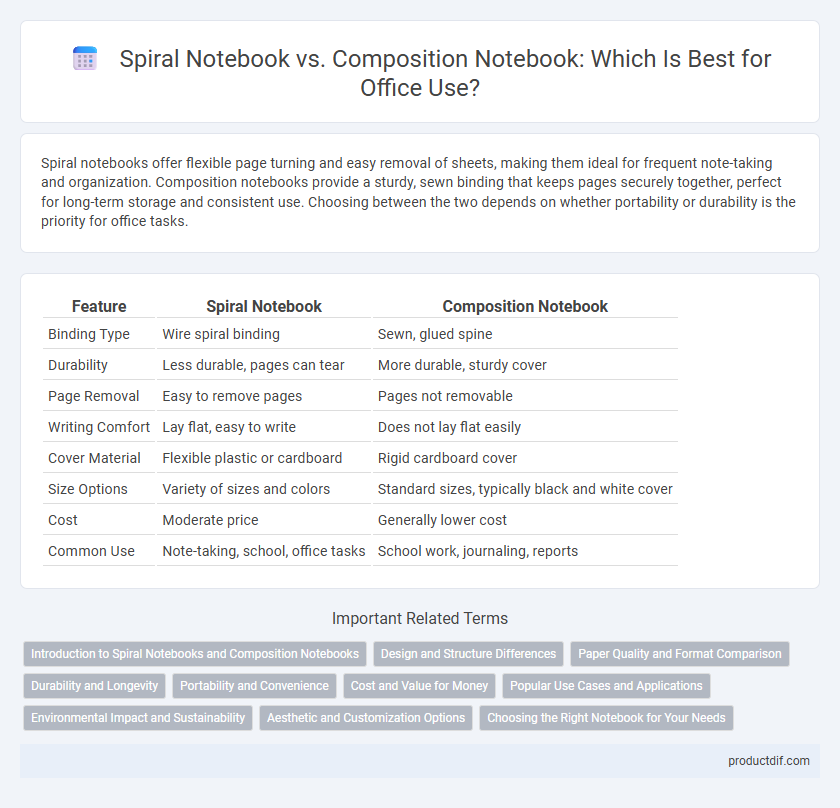Spiral notebooks offer flexible page turning and easy removal of sheets, making them ideal for frequent note-taking and organization. Composition notebooks provide a sturdy, sewn binding that keeps pages securely together, perfect for long-term storage and consistent use. Choosing between the two depends on whether portability or durability is the priority for office tasks.
Table of Comparison
| Feature | Spiral Notebook | Composition Notebook |
|---|---|---|
| Binding Type | Wire spiral binding | Sewn, glued spine |
| Durability | Less durable, pages can tear | More durable, sturdy cover |
| Page Removal | Easy to remove pages | Pages not removable |
| Writing Comfort | Lay flat, easy to write | Does not lay flat easily |
| Cover Material | Flexible plastic or cardboard | Rigid cardboard cover |
| Size Options | Variety of sizes and colors | Standard sizes, typically black and white cover |
| Cost | Moderate price | Generally lower cost |
| Common Use | Note-taking, school, office tasks | School work, journaling, reports |
Introduction to Spiral Notebooks and Composition Notebooks
Spiral notebooks feature a durable wire binding that allows pages to lay flat and be easily torn out, making them ideal for note-taking and organization. Composition notebooks use sewn binding with a sturdy cover, offering enhanced durability and preventing pages from being removed without damage. Both notebook types cater to different preferences in portability, usability, and longevity in office and academic settings.
Design and Structure Differences
Spiral notebooks feature a durable metal or plastic coil binding that allows pages to lie flat and be easily torn out without damaging the book, ideal for quick note-taking and organization. Composition notebooks have a sewn spine and a rigid cardboard cover, offering enhanced durability and a classic look, suitable for long-term use and archival purposes. The structure of spiral notebooks supports flexibility and customization, while composition notebooks emphasize stability and protection of contents.
Paper Quality and Format Comparison
Spiral notebooks typically feature perforated, medium-weight paper ranging from 70 to 90 GSM, ideal for easy page removal and frequent note-taking. Composition notebooks use sturdier, thicker paper around 90 to 100 GSM, often non-perforated, designed for durability and long-term archival purposes. The format differs with spiral notebooks offering flexible page management and standard letter size, while composition notebooks maintain a fixed binding with ruled pages suited for formal documentation.
Durability and Longevity
Spiral notebooks feature sturdy wire bindings that allow pages to lie flat and resist tearing, enhancing their durability for daily use. Composition notebooks, with their sewn bindings and thick cardboard covers, offer superior longevity by securely holding pages together and protecting against wear. Both options provide reliable durability, but composition notebooks excel in long-term preservation of notes.
Portability and Convenience
Spiral notebooks offer superior portability with their lightweight design and easy page-turning feature, making them ideal for on-the-go note-taking. Composition notebooks provide durability with a sturdy cover but are bulkier, which can limit convenience during travel. Users prioritizing quick access and flexibility often prefer spiral notebooks for efficient organization and ease of use.
Cost and Value for Money
Spiral notebooks typically offer a lower upfront cost, making them a budget-friendly option for students and professionals needing quick note-taking solutions. Composition notebooks, while slightly more expensive, provide durable covers and sewn bindings that enhance longevity, delivering better value for money over time. Choosing between the two depends on balancing initial expenditure with the need for notebook durability and extended use.
Popular Use Cases and Applications
Spiral notebooks are preferred for note-taking in classrooms and meetings due to their easy page-turning and ability to lay flat, making them ideal for fast, organized writing. Composition notebooks are favored for journaling and long-term archiving because of their durable covers and securely bound pages, which prevent sheets from falling out. Both types are essential for students and professionals, with spiral notebooks supporting dynamic note-taking and composition notebooks offering reliable, structured documentation.
Environmental Impact and Sustainability
Spiral notebooks often use plastic coil bindings and glossy covers, which can hinder recycling efforts and contribute to plastic waste, whereas composition notebooks typically feature cardboard covers and sewn bindings, making them more eco-friendly and easier to recycle. The paper in composition notebooks is frequently made from recycled materials, reducing the demand for virgin pulp and minimizing deforestation compared to many spiral notebooks. Choosing composition notebooks supports sustainability by promoting biodegradable components and reducing the environmental footprint of office supplies.
Aesthetic and Customization Options
Spiral notebooks feature exposed coils that offer a modern, flexible aesthetic and allow pages to be easily removed or rearranged, enhancing customization for personal or professional use. Composition notebooks typically have a more classic, sturdy design with a sewn binding, limiting page removal but offering durable covers that support surface customization through stickers or artwork. Both notebook types cater to different aesthetic preferences and customization needs, with spiral notebooks excelling in modular design and composition notebooks providing a timeless, resilient appearance.
Choosing the Right Notebook for Your Needs
Spiral notebooks offer ease of page removal and flexibility, making them ideal for students and professionals who require quick note organization or frequent edits. Composition notebooks provide durability with sewn bindings and a classic design, perfect for long-term note retention and archival use. Selecting between spiral and composition notebooks depends on your need for portability, page permanence, and writing style preferences.
Spiral notebook vs Composition notebook Infographic

 productdif.com
productdif.com